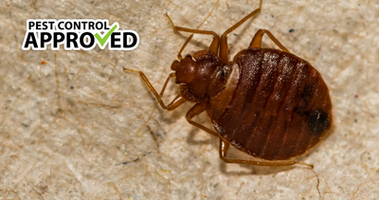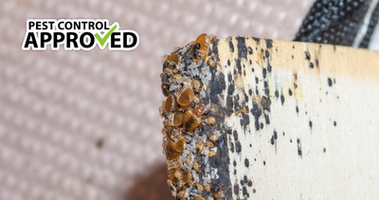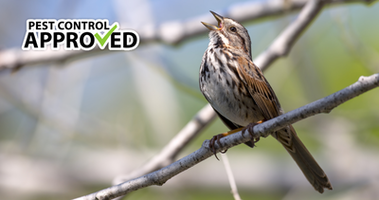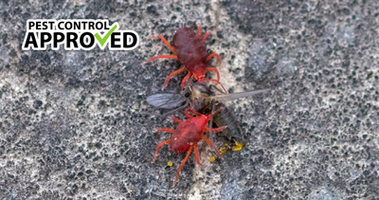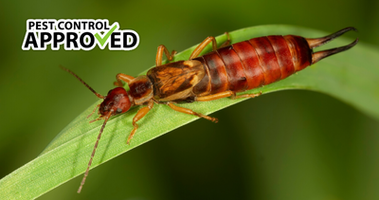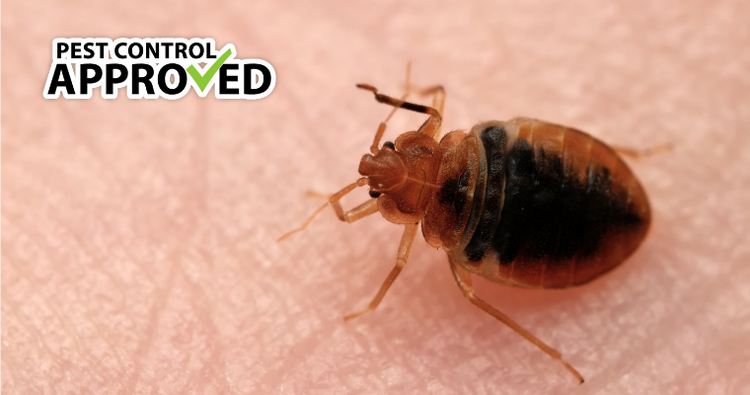
Sleep tight and don’t let the bed bugs bite. But what if the bugs bite? How do you get rid of a bed bug infestation? Hang on tight. We’ll answer all of your questions. Bed bugs are small reddish-brown insects that attack humans and feed on their blood. Being small and sturdy, these bugs hide in cracks and crevices and patiently wait for their victim. You may encounter them in your home, hotels, hospitals, offices, schools, and similar places.
Since they lurk in the folds of fabric or mattresses, an infestation can easily be transmitted from place to place. Vigilance is imperative for control. Along with being able to suck your blood and transmit parasites and pathogens, the mere thought of a bed bug bite is unnerving. These bites can be irritating and might even induce allergic reactions, making your nights sleepless and your life comfortless.
Bed bugs spend most of their time waiting or resting. They are nocturnal and bite their unwary victim in the dead of the night. Their piercing mouthpart, the proboscis, is elongated and can puncture all the skin’s layers to access the rich blood reservoir below. Normally, these bugs feed weekly to fulfill their nourishment requirements and to procreate.
Controlling bed bug infestations is a multi-step process and very practical. In short, bed bugs can be terminated, but only through a systematic process. First, they need to be identified properly and then you need to take a series of steps to cut off their population growth and destroy the infestation.
How to Keep Bed Bugs Away?
As the proverb goes: an ounce of prevention is worth a pound of cure. You can take certain precautions to prevent a bed bug infestation. We have listed some of them below:
The most probable cause of an infestation involves travel. The bugs often hitch a ride on your clothes and assorted belongings. The first thing to do is to inspect your luggage items with a keen eye.
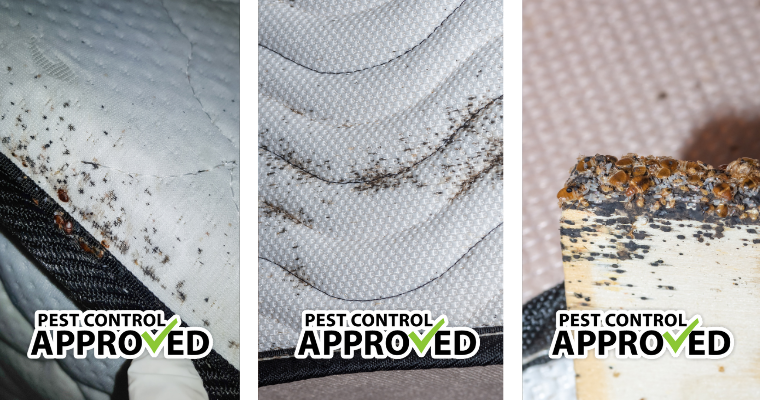
Some precautionary steps include:
- Seal your clothes and assorted items in plastic bags.
- Instead of placing your luggage items on the bed, use luggage stands.
- Steam or spray (with insecticide) your luggage items.
- Place pest strips in your luggage.
- Immediately empty your clothes directly into the washing machine and wash them with hot water when you return home.
During your stay, examine the bed’s mattress and sheets for any signs of an infestation. Common tourist spots are often infested, but not every bug is a bed bug.
1) Thoroughly Dry Your Luggage
Thoroughly wash and dry your used luggage to eliminate any possibility of a bed bug infestation. The process can be broken down into three steps:
- Sort clothes into two groups: those that need to be dry cleaned and those that don’t.
- Wash the remaining clothes in a washing machine.
- If your house is infestation-free, put away your clothes; otherwise, keep them separate.
2) Use Direct Heat
There are many products that you can use to apply direct heat to your belongings and eliminate any risk of bed bugs. You can use such products instead of washing machines and dryers. The products include portable heat chambers, a hair dryer, or a steamer. The temperature must reach above 45⁰C (113⁰F).
3) Be Careful Buying Second-Hand Clothes or Furniture
With online buying/selling options on the rise, getting your hands on some decent second-hand furniture is easy. If you buy a second-hand chair or sofa, thoroughly inspect it for signs of an infestation. Small dark spots, called fecal pellets, are a clear giveaway. Have the furniture heat-treated (under direct sunlight) to kill off the bug infestation. The same goes for clothes (which must also be thoroughly washed), carpets, and mattresses.
4) Look Out for Any Initial Signs
Like all infestations, tackling a bed bug invasion is far easier during its initial phase. Having a keen eye for detail may save you the expense of calling in the professionals.
Some important warning signs are:
- Bites: Although bed bug bites feel like mosquito bites (who also employ a proboscis to puncture the skin), they are easily distinguished. Initially, you may only get a handful of itchy bite marks, but they will end up being more numerous and itchy. Not only do bed bug bites irritate your skin more, but they also take longer to heal and can leave behind scars.
- Bloodstains on Sheets: Another clue pointing towards a bed bug invasion is blood. After a hearty blood meal, the insect will hastily crawl away from you but occasionally the creeper may get squished if you roll over in your sleep. As the bug gets killed, it leaves behind a tiny dot of your blood. This is an important clue that must not be ignored.
- Fecal Pellets: As noted earlier, small dark spots clustered on sheets is an indication of an infestation and must not be taken lightly.
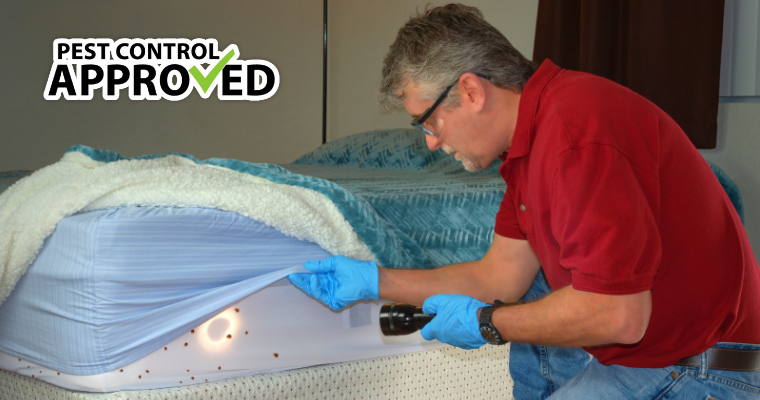
Properly Identifying a Bed Bug
Correct identification is the first and the most imperative step in the extermination of bed bugs. Strategies for combating insects vary between species and you must know exactly what your target is. Generally, bed bugs can be easily identified but certain lookalikes make matters more complicated.
Insects are the most diverse and the biggest subgroup of arthropods that also include crustaceans, arachnids, and myriapods. Bed bugs belong to the Cimicidae family, which hosts around 100 unique species. Since members of the same subgroups often share a superficial resemblance, it is no wonder that many bed bug look-alikes abound the insect realm.
We have listed below some comparisons between bed bugs and their look-alikes, so you know exactly what you’re facing:
Bird Bugs vs. Bed Bugs
Bird bugs, also known as bird mites and bird lice, share several superficial features with bed bugs; however, bird bugs are much smaller and look like black pepper bits. An adult bird bug is only a tenth of the size of an adult bed bug, which can reach up to 5mm in length.
As the name suggests, bird bugs target birds and, once the fowl dies, they look for other sources of warm blood. Usually, these bugs end up infesting our households. Since they can survive for up to 9 months without food, they are particularly hard to eliminate. You must deal with them differently, because they have certain features that distinguish them from bed bugs. Some of these features are:
- They are much smaller in size - almost one-tenth the size of a bed bug.
- They dwell on their hosts, while bed bugs bite, feed, and then leave.
- They leave no fecal pellets or any trace behind.
- Their primary victims are birds, but they may bite people when the birds are unavailable.
- They cannot reproduce on a diet of human blood alone.
If you feel like you have bird bugs, then thoroughly inspect your animals and every nook and cranny of your house. The attic, gutters, and adjacent trees are common entry points for these. Your first step is to cut them from their source and then exterminate the remainder.
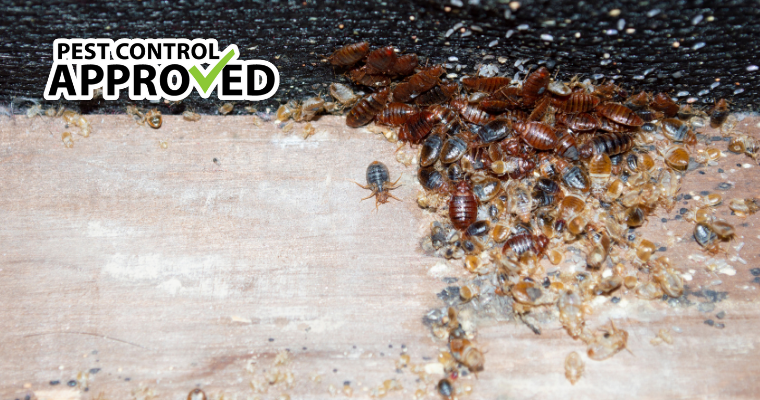
Bat Bugs vs. Bed Bugs
Bat bugs are closely related to bed bugs and share many physical similarities. They are believed to be the bed bugs’ ancestors. However, if you have a keen eye, you can always differentiate between the two based on some distinguishing traits:
- They rely heavily upon bats as their primary food source.
- They cannot reproduce via feeding upon human blood.
- They have longer hair compared to bed bugs.
If you've come across bat bugs, eliminate the bats first. If any bat is hiding, or worse, lying lifeless in a dark and dusty corner of your house, remove it. Find all possible entry points and eliminate them. Fumigate any hiding spots within your home to strike the final nail in the coffin. The best way to help relocated bats from inside your home is to set up an exterior Bat House which can provide shelter and safe housing.
Fleas vs. Bed Bugs
Although fleas do not share any physical attributes with bed bugs, they do infest in the same manner. Fleas often inhabit our beds and bite us in our sleep. But fleas differ a great deal from bed bugs in the following ways:
- They are much smaller than bedbugs.
- They can jump.
- They infest areas other than beds and sheets.
- They transmit diseases.
- Flea bites are erratic and itchy; these marks resemble a white halo.
- Fleas prefer to attack your lower legs and feet.
The Black Death in Medieval Europe was spread by fleas and flea eggs. They would bite infected individuals and carry the bacteria to healthy people, escalating the infection cases and killing thousands. The reaction to flea bites varies among people. While some get profound rashes, others may only exhibit small itchy red spots.
The most common way fleas enter a home is via animals. These invaders can catch a ride on many different animals. If you are a proud dog owner, then you'll need to be extra careful. Fleas can be transmitted by other animals and your pet will then carry them to your house. Most people let their dogs sleep with them, which poses a risk of its own. It provides a direct route for your dog's fleas to your bedding and then you.
The best precaution is a flea collar for your loyal companion. Other than that, you’ll have to be vigilant and keenly observant about your dog’s surroundings. Be on the lookout for a flea infestation and nip it in the bud. Use a flea-killing dog shampoo regularly and use flea traps to prevent a problem. How long can a flea live without a host can vary, but usually a few months to a year depending on what life stage the flea is in.
If you don't own a pet but still have a flea problem, chances are you got them from a wild animal. Squirrels and other rodents often hide in the corners of your home and squirrel poop can carry several diseases. These furry little creatures are carry parasites like fleas. It is important to inspect and seal away all possible access points to your home to prevent rodents and fleas.
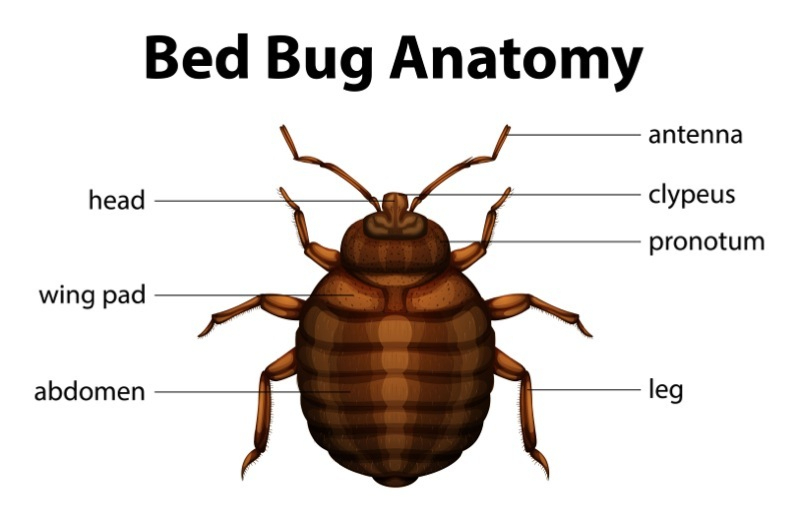
Mosquitoes vs. Bed Bugs
Many people believe bitten by mosquitoes even though it’s actually bed bugs. The problem stems from the fact that mosquito bites and bed bug bites are similar in appearance. Most people also fail to inspect their surroundings and ignore clear indications of a bed bug invasion until it is far too late.
Some common indications of mosquito bites are:
- Welts appear almost immediately after a mosquito bites you.
- Mosquito bites heal comparatively sooner, and their after-effects do not linger.
- Mosquitoes are notorious for infecting individuals with a host of infectious diseases.
- Their bites are restricted to bare skin, while bed bugs crawl underneath your clothes to bite.
Mosquitoes seek stagnant water pools to breed. If you wish to eliminate mosquitoes, then remove their source: standing water. Spray the outside of your house with mild insecticide and use electronic mosquito repelling devices at night to mitigate the problem. Mosquito repellent creams are also effective.
Do Bed Bugs Carry Diseases?
Since bed bugs contain certain “neutralizing factors”, the chances of disease transmission are not very high. Generally, a bed bug bite will not pose a serious threat; however, there are a few diseases that are associated with bed bugs.
A research study published by the Oxford University Press incriminated bed bugs in a disease transmission incidence. A 67 year old man, who had been bitten multiple times, developed rashes and skin irritations. These developments were correlated to the bed bug bites. A similar study undertaken by Austral Entomology further validated this case. Two researchers volunteered to be bitten by bed bugs. Several bed bug bites caused skin rashes, irritation, itchiness, and hives. More followed this initial attack, as the researchers began experiencing allergic reactions and periodically sweated profusely. The strange thing is that these researchers were bitten before with minimal reaction.
Unless you are prone to allergic reactions, bed bug bites will not do much damage apart from irritation, redness, and mild swelling of the bitten area. The most severe repercussion of a bed bug bite might be emotional duress.
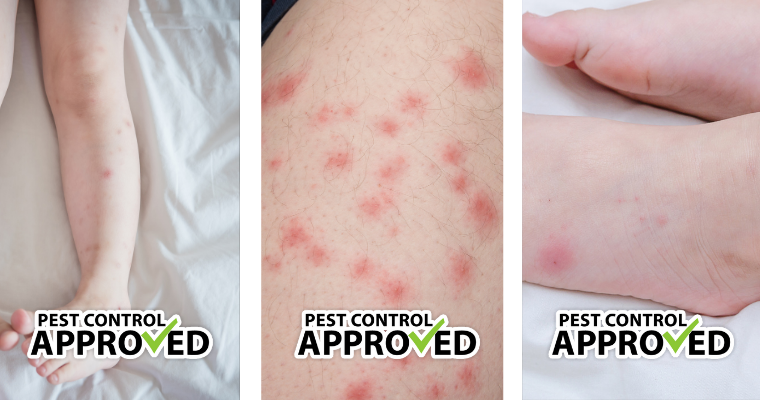
How to Treat Bed Bug Bites?
If you get bitten by a bed bug, do not scratch the area. Instead, apply antiseptic creams or lotions on the affected area, and take an antihistamine to soothe the swelling. Doctors will frequently prescribe treatment for the itchiness, instead of for the bite itself. The irritation will subside within a week.
Bed bug bites tend to last much longer than mosquito bites. After healing, these bites will leave minute scars. Bed bug bites are far more irritating compared to mosquito bites. Although the feeling is hard to describe in words, the bite will have a certain nuisance to it. This feeling will trigger thoughts of a bed bug infestation.
Step-by-Step Process of Bed Bugs Extermination
Bed bugs are tiny - tinier than a pencil eraser. They measure a maximum of 5 mm. Despite their small size, they are smart, tough, and persistent. They lurk in the most unsuspected areas and can easily avoid detection. They can survive for months without food and still procreate rapidly. Not only does their bite hurt, but with a swarm of them digging into your skin, you might face serious medical threats such as anemia.
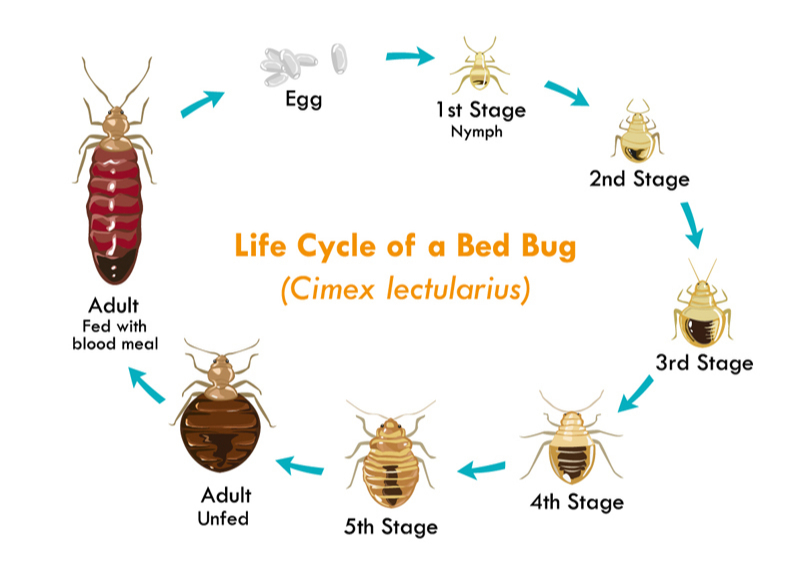
Fortunately, they are not invincible; they can be dealt with, their invasion checked, and their attacks countered. You can eliminate bed bugs with a combination of chemical and non-chemical methods. Although the former may only be employed in case of a larger infestation, it guarantees the best results. The prudent course is avoidance but, when confronted with a pest attack, there is no option but to respond.
Here is a step-by-step guide for bed bug extermination that you can use once you have confirmed their presence:
1) Stay Calm
The worst thing you can do when faced with an infestation is to panic and overreact. Starting a decontamination rampage and pumping tons of pesticide compounds into our home is a bad idea. There are two things you must consider when dealing with a pest: effectiveness of the method employed and the safety of the people. These compounds will not be effective if they are just haphazardly sprayed around your house. Being calm is an important part of the extermination process because, without it, this entire process might fail.
2) Determine the Degree of the Infestation
A bed bug infestation may be localized or widespread. Knowing the extent of the infestation is an important prerequisite to solving the problem. Smaller infestations are easier to address; however, they are harder to spot. Owing to their sleek figures, bed bugs slide effortlessly into crevices and tight spaces, evading detection. If you are unable to spot bed bugs by yourself but are certain that an infestation is present, call in an expert. Pest Control Professionals can use trained dogs to sniff out and pinpoint bed bugs.
If you're taking a DIY approach, consider searching the following locations:
- Sheets, carpets, and rugs.
- Near mattresses.
- Inside the crevices and cracks of bed frames and other wooden frameworks.
- In the baseboards.
- Between cushions and the space behind/underneath them.
- In furniture.
- Behind loose wallpaper.
- Behind posters, paintings, and other wall-hanging items.
Go through the above-mentioned areas with extreme care and vigilance. Use a magnifying glass and flashlight to aid you in this process.
If you spot one or more of the following signs, there is a confirmed bed bug infestation:
- Live bed bugs.
- Fecal pellets that appear as dark spots - the size of a full stop or period.
- Reddish blood stains or spots from dead bed bugs on sheets and mattresses.
- Miniscule, pale yellow eggs, their shells, or molted exoskeleton (also yellow).
If you spot a bed bug, capture it, and store it in a jar with rubbing alcohol. Send the sample to an expert for a final word on identification. Do this step even if you are sure that the culprit is a bed bug.
3) Halt the Advance of the Infestation
Once you ascertain that there’s an infestation, you need to further prevent the spread of the bugs. Bed bugs will become an even greater menace if they spread throughout your home.. One important technique is vacuuming your bed, dresser, carpets, electronic devices, and all other suspected areas.
After vacuuming, seal the vacuumed contents in a plastic bag and throw them away. Thoroughly clean the vacuum itself to ensure that none of them remain. Seal all of your infested clothing in plastic bags and then wash them one by one. After washing, dry them using a dryer that is set to maximum temperature.
If you can’t wash or dry something, keep it sealed for several months to kill off all the bugs. If your furniture is dangerously infested, break it into pieces and throw it out. Spray-paint the words “bed bugs” on it so no one takes it home.
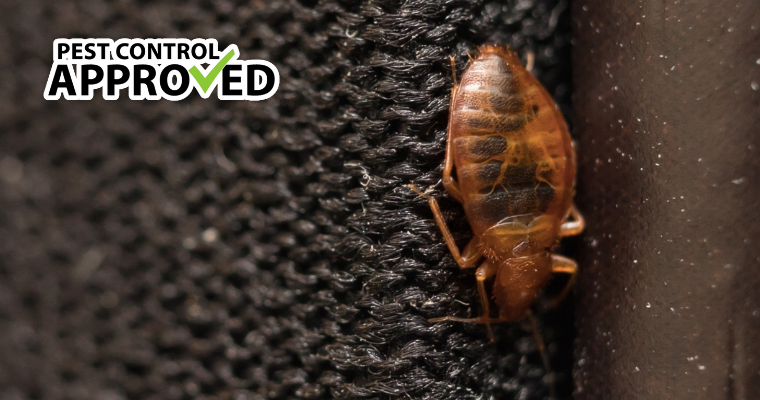
4) Preparations for Bed Bug Extermination
Preparation ensures a higher success rate. Before you begin the actual hunt, prepare well beforehand. After cleaning away any possible infested household items (as discussed in the previous step), eliminate bed bug hiding places.
Pick up all items lying on the floor that may house bed bugs and throw out as many of them as you can. If you can, wash and dry them on high heat. Books, magazines, clothes, and anything under your bed, etc. are all at risk. Remember not to move anything from an infested room to a clean one, lest you propagate the invasion.
Then move on to sealing all open access areas. Glue down any loose wallpaper. Fill up all the cracks and crevices in the woodwork. Seal any open areas. Tape up open electrical outlets. Finally, move your bed at least 6 inches away from the wall so that bed bugs aren’t able to climb it.
5) Extermination
It is quite easy to kill bed bugs; you can employ both chemical and non-chemical means to do so. In homes with pets and children, the latter is recommended. High heat (above 46C) or intense cold (below 0C) are potent weapons used to kill bed bugs.
Some easy methods to successfully exterminate bed bugs are:
- Wash your clothes, beddings, curtains, and assorted items in hot water for at least 30 minutes. After this, throw them in a dryer (set to its maximum temperature) for another 30 minutes.
- Use a steamer to kill bed bugs in carpets, rugs, mattresses, and cushions.
- Pick up infested items and expose them to direct sunlight on a hot day. The heat will kill the bugs.
- If you plan on using the extreme cold approach, place the bags containing infested items in your freezer for at least 4 days.
- After cleaning up the infested items, prepare to counterattack. By placing bed bug-proof covers over any mattresses and box springs, you will prevent access and will kill those already present. Make sure to properly zip up these covers.
If you are done with these steps and you still face an infestation, it is time to use insecticides. Insecticides are potent poisons and should never be taken lightly. You must follow all the safety protocols dictated on the cover. Make sure you get insecticides that are EPA-approved and are marked specifically for bed bugs.
Below, we have listed some of the common types of insecticides that are suitable for bed bugs:
- Pyrethrins and pyrethroids are commonly employed for bed bug extermination; however, many bedbugs are now resistant to them.
- Pyrroles, such as chlorfenapyr, attack the bugs at a cellular level and are potent bug killers.
- Neonicotinoids are synthetic nicotine-like compounds. They target the bug’s nervous system and are effective in taking down hardy insecticide-resistant bugs.
Another option you can use instead of insecticides are desiccants. These compounds target and destroy the bug's exoskeleton, or the outer covering. Without this covering, the bugs will dry out and perish. Silica aerogel (Tri-Die and CimeXa) and diatomaceous earth are two effective desiccants. Although these products are slow-acting and they may take several months to work, bed bugs cannot become resistant to them.
Bug bombs, more formally known as foggers, are also potent bed bug killers. They have one limitation though, and that is that they can’t enter crevices and cracks. Foggers are also toxic to humans. They should only be used by professionals. If you get a room fumigated, leave it alone and lock the door so no one wanders in by accident.
Natural compounds, synthesized by plant oil such as EcoRaider and Bed Bug Patrol, have the advantage of being non-toxic. They work almost as well as toxic chemicals but have fewer drawbacks.
Inspecting the Infested Locales
Bed bug extermination requires some time. Wait a few weeks before determining whether or not you’ve eliminated the infestation. Regularly inspect the infested areas once a week for any signs of bed bugs.
Place bed bug interceptors next to every leg of your bed to make spotting easier. These devices will intercept and capture bed bugs before they can even reach your bed. Continue to check these interceptors and keep them deployed for a full year.
Retreat to Fight Another Day
It always wise to avoid a fight that you can’t win. Bed bugs are hardy creatures and odds are that, if the infestation is severe, your efforts might prove to be ineffective. If you feel like you’ve done everything humanly possible and yet an infestation continues, seek professional help.
Bring in the Pros
Once you’ve exhausted all of your efforts or if you don’t have the resources to fight in the first place, bring in reinforcements. Professionals are much better equipped and well-trained to tackle such problems. Pest control companies exclusive have access to chemical agents that kill off pests and linger in the crevices until they are all gone.
They also employ whole room heat treatments, which you can’t do on your own. Their equipment elevates the room temperature to a whopping 35⁰C to 62⁰C (135⁰F to 145⁰F). at this temperature, bed bugs are sure to die.
However, even seeking professional help requires certain preparations. Agencies usually provide detailed instructions and guidelines to help you set up your home for their operation. Normally, it takes 3 to 4 professional visits to get the work done. They will also ask you to stay out of the room they treated, as the insecticide inside is toxic and must be allowed to dry out.
Tips For Hiring An Exterminator
- Is the company state-licensed?
Ask them and, even if they say yes, check with the Department of Agriculture. You can simply visit their website and access their contact information from there.
- Does the company have any credible references?
Again, validate their response by conducting a personal research. Surf through platforms like LinkedIn, Yelp, Google, and Facebook to confirm their claims.
- Do they offer a guarantee?
Bed bugs are notoriously tough. If the company is not confident in their work, they'll find excuses as to why they can't guarantee anything. Although connected apartments and condos are hard, any decent company should have no issue in dealing with pestilence in a free-standing home.
- Do they offer liability insurance?
If they don’t, avoid them at all costs.
- How long does a treatment session last?
Ideally, a thorough session should last between 1 to 2 hours.
- How many treatment sessions do they offer for one payment?
Decent companies offer two sessions for one payment. The initial session is followed by a follow-up session a week or two later. If a company offers more, it might reflect a lack of experience.
- What sort of treatments do they offer?
Insecticides are the most common choice for bed bug extermination; however, many bugs have acquired resistance to them. It is thus imperative to have multiple treatment options, including steaming, whole room heating, etc.
- Do they cover the entire house in the treatment?
Ideally, they should. Otherwise, the whole extermination process might end up being too expensive.
- Do they inspect the areas before using insecticides?
An experienced worker will never apply insecticides before inspecting an area.
Being Proactive Is Key
Once you remove the bed bugs, make sure they never come back again. Here is a brief re-run of precautionary steps you can take:
- Never leave items like papers, magazines, books, clothes, etc. lying on the floor.
- Always keep your mattress and box spring covered with a bed bug cover and keep it firmly zipped.
- Regularly vacuum and wash carpets, furniture, curtains, and bedding.
- Never buy second-hand furniture or clothes.
- Seal all crevices and cracks throughout your house to seal off any entry points and hiding places for the bugs.
- Avoid bed bugs while traveling, i.e. keep a keen eye out for them in your hotel room.
Bed Bugs Extermination – Do's and Don'ts
Whether you’re starting the extermination process or in the middle of it, consider these do’s and don’ts of bed bug extermination:
Do's
- Employ heat to kill bed bugs.
- Use bed bug traps to contain the problem.
- Wash clothes with hot water (above 46oC).
- Check box springs, mattresses, furniture, and clothes for signs of an infestation.
- Invest in a beg bug-proof cover for your mattress.
- Use desiccants, such as silica gel.
- Employ professional pest control companies after conducting thorough research.
Don'ts
- Don’t use foggers on your own.
- Never handle a severe infestation on your own.
- Never transfer materials from an infested room to a clean one.
- Don’t start pumping insecticides throughout your home.
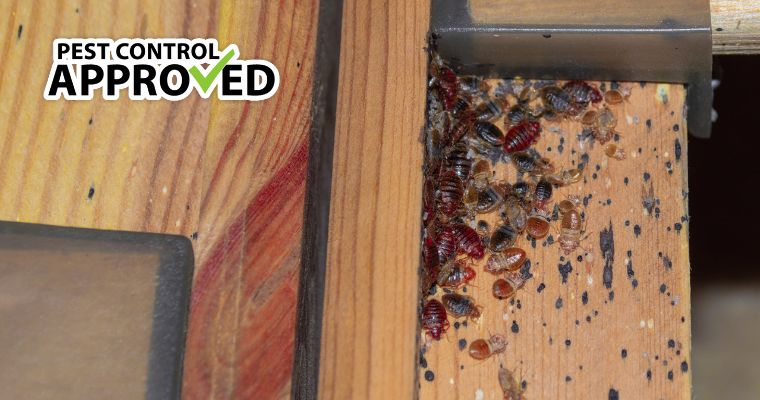
Debunking Bed Bug Myths
Bed bugs’ notorious reputation has inspired many myths. We have debunked many of them below:
- Bed bugs cannot jump or fly; they are no more mobile than an ant. They have great climbing abilities but that’s it.
- They do not normally spread diseases.
- They are nocturnal but leaving the light on does not deter them. When a person is fast asleep, they use the rise in the CO2 level as their cue.
- Bed bugs do not always bite and sometimes it will take time for a bite to show itself.
Commonly Asked Bed Bug Questions
Here are some frequently asked questions about bed bugs:
Q: How effective are green insecticides?
A: Although synthetic insecticides are unparalleled in their strength, green insecticides also pack a considerable punch. Green insecticides are very potent and are endorsed by many parties. The are several control measures for Bed Bugs like glue boards, pheromone traps, laundry, and vacuuming that can help fight active infestations while also being proactive.
Q: What sort of luggage is suitable for avoiding bed bugs?
A: We would suggest trying hard, zipper-free luggage.
Q: How to ascertain if you have a bed bug infestation?
A: Bed bug bites, fecal pellets, minuscule eggs, eggshells, molted exoskeletons, and live specimens are clear indications of a bed bug infestation. Tiny blood spots on the sheet are also strong evidence.
Q: How to identify a bed bug?
A: Normally, an adult specimen will measure up to 5 mm in length. They are around the size of an apple seed and are reddish-brown in appearance.
Q: Can a bite mark be used to identify the culprit?
A: No. Although a bed bug bite has a slightly distinct feeling, it cannot be diagnosed with certainty. You can only use the specimen itself for identification purposes.
Q: How do beg bugs enter our homes?
A: Bed bugs mostly hitch a ride with your luggage during travel. Bugs also enter houses from adjacent houses, trees, crevices, and cracks. Avoid purchasing secondhand furniture which could have bed bugs inside.
Q: How do bed bugs successfully hide in our homes?
A: Since they are small and smart, they avoid detection. They hide in crevices, cracks, folds of fabric, and mattresses. They can hide in every nook and corner, out of sight.
Q: What do bed bugs feed on?
A: Bed bugs are primarily ectoparasitic fluid feeders. They feed mostly on mammalian blood and prefer human blood.
Q: Why are bed bug bites irritating?
A: When bed bugs bite, they secrete anticoagulants into the puncture wound to keep the blood from clotting. Many people are allergic to this anticoagulant and thus the bite area is irritated.
The Conclusion
A bed bug infestation is a serious and ever-present danger, especially for frequent travelers. These creatures, though small, have a devastating effect and are hard to remove. If you ever face a bedbug infestation, carry out the steps above with extreme care. If you are not up to the challenge, you should employ a professional.


